Zadar Inspectors Check Nightlife and Crash Wedding, Seeking COVID-19 Violations
July 1, 2020 — A spike in nightlife-related coronavirus infections prompted Zadar's Civil Protection Directorate to send inspectors to clubs, cafes, parties and even weddings. While most businesses adopted the recommended precautions, one violation was noteworthy and inspectors found several omissions.
Zadar's inspectors spent the weekend club crawling and checking the nightlife scene, according to Zadarski List. The head of the unit, Mate Lukić, said in a report to the city's authorities that most businesses subjected to the 73 inspections followed protocols.
"It is my pleasure that, except in one case, I can say that we did not notice any major omissions given that all facilities did their best to adhere to the recommendations, and even in the part where they are not obliged to do so," he said. "We were even at parties."
Nightclubs and late-night social events became a flashpoint in Croatia's coronavirus fight after a large number of young people in Zagreb have been infected in recent days,
The inspections uncovered slight departures from the rules, which inspectors let off with 17 warnings.
"The members of the Civil Protection Unit are more than fair to the citizens," Lukić said. "We often act educationally because these sudden changes related to the appearance of the virus confuse the citizens as well."
The inspectors did, however, fine one establishment for having water in what was supposed to be a disinfectant bottle.
A majority of citizens adhered to measures, Lukić added, with some establishments going out of their way to impose the rules upon guests. At the outdoor bar "Hype", for example, all staff members from guards to waiters use protective equipment. Hostesses disinfect guests' hands before entering.
The hardest part of the job was inspecting weddings, Lukić said, crashing unannounced into the most important day of the year for the newlyweds. The inspectors were met with some pushback as they did their job, though the results were more than satisfactory — it turned out that the wedding organizers and the owners of the facilities respected the measures.
The team included two inspectors and two police officers, Lukić added.
"As a unit leader who monitors the situation on the ground on a daily basis, I can say that I am glad that people are adhering to the measures so carefully, accepting the new situation in which we must protect ourselves and others to the maximum," Lukić said. "On the other hand, we see that the people of Zadar have continued with their usual life because, judging by our tours of the clubs, the nightlife is active."
The Chief of the Civil Protection Directorate of the City of Zadar, Ante Babić, said the latest measures came after the Adria Tour and an increase in visitors sparked concern over more potential infections.
"We usually issue warnings, but as the police and the State Inspectorate visit the facilities, misdemeanor proceedings can be initiated for serious violations of measures," Babić said.
Split Epidemiologist Has No Fears Over New Infections
June 21, 2020 — Dr. Diana Nonković, head of Epidemiology at Split's Public Health Institute, in an interview with N1 listed the most common symptoms found in COVID-19 patients, adding the resurgence of coronavirus in Split was not a cause for concern as long as authorities can trace the source of the infection.
"If we know that two thirds of our newly-infected patients are concentrated in a family and we know the path of infection and that cases have been imported, then it is not so terrible," she said.
Asymptomatic patients make her job much more difficult.
"The virus is spreading very fast and it's very contagious," she said. "We saw that right at the beginning and that's why we always try to test it promptly."
A common symptom is the loss of sense of smell and taste and this is associated with the effect of the virus on the respiratory system, called anosmia. Many of the mildy-infected people had only this symptom.
Nonković added authorities banned visits to homes for the elderly, and yesterday the directors of the homes consulted with epidemiologists.
"According to the origin of the virus, we all expect it to be less manifest and less circulating during the warmer part of the year, but we are worried about our environment because if there is increased spread, it will happen in Croatia, and unscrupulous tourists can bring the virus, " Nonković said when asked if the number of people infected with coronavirus could escalate.
Coronavirus's Other Symptom In Croatia: Depression
June 16, 2020 — The coronavirus pandemic and ensuing response caused a spike in mental health problems, with one-fifth of Croatian citizens reporting increased levels of anxiety, depression and stress.
A survey conducted by the Faculty of Philosophy in Zagreb showed psychological consequences directly tied to the pandemic in one-fifth of all participants; 25 percent of respondents developed mental disorders, and 40 percent of citizens who previously had certain mental disorders said their condition worsened.
The study surveyed a sample of 3,500 adult respondents of all ages. Its full results will be unveiled on Thursday, according to Vecernji List.
The research on the psychological consequences of the pandemic was conducted through an online survey, so it can be assumed that it was completed by more computer-literate and better-educated citizens from all over the country.
“While, as expected, stress and anxiety were felt equally by all age groups, single people, older people, citizens living in families with unsettled relationships and citizens who previously had mental disorders were more depressed,” psychology professor Gordana Kuterovac Jagodić from the Faculty of Philosophy in Zagreb told Večernji List.
Although during the epidemic, which is now subsiding, it has been constantly pointed out that senior citizens are the most vulnerable and at-risk group for corona infection, it is surprising that most seniors consider themselves at low risk.
Only 38 percent of senior citizens stated that they consider themselves more vulnerable than other groups of citizens, while 28 percent of retirees are very worried that their pensions will be reduced.
Parents who worked at home while staying with their young children endured the biggest drop in mental health.
Petrana Brečić, director of the Vrapče Psychiatric Clinic, said their office received calls for psychological help from citizens who had never had psychological difficulties before.
Doctors who were on the first line of defense against the corona are also expected to have problems with PTSD due to the crisis caused by the coronavirus.
COVID-19, which had hit the whole world, is an extraordinary situation that has necessarily caused an increased need for people to adapt. During the period of semi-isolation, which also entails economic consequences, it is normal for people to have different emotional reactions and some psychological symptoms, such as stress and anxiety.
Many citizens developed symptoms or disorders, most often anxiety, had problems with insomnia, were nervous, or tense.
When it comes to the mental health of citizens, bigger problems could only be seen over time, in a few months.
“When on a practical and everyday level we begin to face the consequences of the crisis, whether health, economic and financial, then, paradoxically, we will have to adapt even harder and this adjustment will be long-lasting and will require a lot of mental effort,” Brečić said. “Personally, I expect that in three, four, six months to a year there will be a lot more impact and consequences of the coronavirus epidemic on our psychic apparatus.”
Then citizens could show symptoms of anxiety disorder, including PTSD, although it will not be PTSD in the common form. It may only be present in people who were at the forefront of the fight against the epidemic and those who were most exposed to the epidemic and earthquake.
“As time goes on people will have more anxiety disorders and depression, which does not have to be a sign of illness, but is a reaction to the situation they have gone through,” Brečić said in an earlier interview in May. “Maybe some people's addiction to psychoactive drugs and alcohol will worsen.”
Croatian Retailers' Sunday Return Constitutionally Dubious
Booking.com: 48% of Croats Want to Travel within Croatia, Apartments Most Popular
May 22, 2020 - Although travel plans are currently on hold, data collected by Booking.com reveals that this has not stopped travel enthusiasts from daydreaming. A look at how travelers in Croatia plan to vacation after the corona crisis.
HRTurizam reports that after reviewing the millions of “Wish Lists” travelers have created on Booking.com over the past two months, with more than 100,000 different destinations recorded since early March, Booking.com has decided to share the top destinations and accommodation units travelers have been thinking about as they wait for when they can start traveling again.
Destinations such as Bali, Andalusia, London, Florida and Paris continue to inspire travel enthusiasts around the world, but due to the uncertain situation in the last two months, as many as 51% of travelers globally have chosen destinations within their country. At the same time, 33% of travelers expressed a desire to visit domestic destinations.
In 2020, as many as 48% of those wishing to visit destinations within Croatia is on the Wish List, which represents an increase compared to 2019, when 38% of domestic passengers said so.
Since the beginning of March, Zagreb, Split, Zadar, Dubrovnik, Opatija, Rijeka, Makarska, Rovinj and Osijek have been at the top of the wish list of domestic destinations from Croatia, which tells us that travelers are looking forward to visiting sunny cities on the coast and beaches, but also the hustle and bustle offered by the big cities in the interior after weeks spent in isolation. Travelers who have already visited these destinations recommend them for their history and beautiful old buildings, walks along rivers or the sea and friendly people.
When we talk about adventures abroad, travelers from Croatia mostly dream of big European cities of culture as well as destinations in neighboring countries. In that list, Istanbul (Turkey) was in the first place, then Budapest (Hungary), London (UK), Belgrade (Serbia) and Paris (France), and in the top destinations were Rome (Italy), Lisbon ) and Sarajevo (BiH).
Also on the Wish List of countries that travelers from Croatia would like to visit are Italy, Turkey, Spain, the United Kingdom and Serbia. Nevertheless, domestic destinations are still a favorite of travelers from Croatia on the Booking.com Wish List.
While dreaming of changing the environment and spending the night outside their home, travelers from Croatia most wanted to stay in apartments, hotels, guest houses, cottages, and resorts. As many as 41% of travelers from Croatia during the last two months have expressed a desire to stay in apartments, which is much more than the global average of 20%.
The three most desirable accommodation units in Croatia for travelers from Croatia are Apartments Lisinski in Zagreb, Madison Luxury Apartments in Zagreb and Plitvice Holiday Resort in Grabovac. The most desirable accommodation units outside Croatia for travelers from Croatia are Apartment East West (Belgrade, Serbia), Nusha Apartments (Belgrade, Serbia) and Alpin Panorama Hotel Hubertus (Trentino Alto Adige, Italy).
"These are challenging times where security is a top priority. At Booking.com, we know that in times like these, thinking about how we’re going to explore the world again has great power that brings us inspiration and a good mood. It’s amazing to see the range of different travel experiences our customers dream about during the period they’ve been waiting for the opportunity to pack up and hit the road again," Maja Vikario, regional manager, told Booking.com.
Interestingly, on the top 1000 global list of the most desirable destinations in the world, there are as many as nine regions from Croatia with Split-Dalmatia County at the top, after which Istria and the Dubrovnik-Neretva County are on the list.
To read more about travel in Croatia, follow TCN's dedicated page.
Croatians Miss Socializing, Travel, and Coffee (Of Course)
May 10, 2020 — The coronavirus pandemic took a toll on a culture used to informal gatherings, family meals, and hours spent philosophizing over a single macchiato. Croatians miss socializing, excursions and trips, and coffee in cafes, according to a recent poll gauging the general mood during the pandemic.
A survey conducted in early May by the Hendal Agency and Franck showed Croats citizens missed spending time with loved ones the most (78 percent), trips and travels (48 percent), and drinking coffee in cafes (44 percent).
The coronavirus epidemic has negatively affected 87 percent of citizens, mostly the inhabitants of Dalmatia, especially emotional life. The last few months since the epidemic upended daily live caused dissatisfaction in 53 percent of respondents. Others felt anger (29 percent) and sadness. (29 percent).
For men, the epidemic mostly caused boredom, for women, sadness. As many as 34 percent of citizens, primarily men, state that the epidemic and restrictions that came with it have caused boredom in their daily lives, while 28 percent felt lonely. Sadness also took hold, especially emphasized by women who took part in the poll.
About a third of respondents (34 percent) try to maintain a positive attitude and hope that life will return to normal soon.
That Croatian citizens are looking forward to the easing of restrictive measures and the reopening of cafes and terraces is shown by the 47 percent who said they will visit a cafe next week to drink a coffee, while a third say they will wait until the pandemic blows over completely. Dalmatians especially are looking forward to drinking coffee in cafes, with 65 percent saying they will first order coffee when they finally sit down at a cafe.
The crisis caused by the coronavirus did not have a significant impact on the habits of 63 percent of citizens when it comes to coffee drinking rituals, as evidenced by the 66 percent of citizens who normally have the habit of visiting cafes and will continue this habit after the epidemic ends.
During the restrictions, 47 percent of coffee lovers said coffee remained a part of their daily ritual. Only the place where they drank changed.
Hendal's earlier research, also conducted in collaboration with Franck, in October last year showed that Croatia is a country of coffee drinkers and "let's go for coffee" is still by far the most common invitation to socialize among Croats, with 87.5 percent using it as an excuse to socialize.
The most popular types of coffee are ground Turkish coffee and espresso in a cafe that is drunk by almost 70 percent of respondents. When coffee is mentioned, 28 percent of citizens cite morning as the first association, 16 percent waking up, 15 percent think of its smell.
Analysis: Coronavirus in Croatia Compared to Other European Countries — May 5 Update
May 5, 2020 — A graph showing the number of deaths from or with the SARS-CoV-2 virus per million population per country places Croatia among the five best-ranked countries with the lowest proportional death toll, according to the Johns Hopkins University Coronavirus Database.
In addition to Croatia, there are Greece, Poland, Bulgaria and - according to the available data - Slovakia. The next low mortality group includes the Czech Republic, Hungary, Finland, Romania, Estonia, Norway, and Slovenia, with the worst situation affecting Belgium, Spain, Italy, and France.
Compared to Croatia, often due to its access to epidemic measures, oft-mentioned Sweden has a death toll of around 14 times per million. Belgium has as many as 35 times more casualties per million inhabitants.

Specifying only the absolute numbers of registered infected persons or persons who died from or with the presence of a new coronavirus per country does not give a true picture of the situation, given that there are huge differences in the populations of individual states.
For example, Belgium with its 11.5 million inhabitants has so far had 7,924 casualties, while Italy with 60.5 million inhabitants has 29,079 casualties, but Belgium has as much as 43% more casualties per million inhabitants than Italy.
It can also be said that Germany with 6,866 deaths has far more casualties than Sweden with 2,769, and in fact, per million inhabitants Germany has 70% fewer casualties than Sweden.
When looking at the number of infected persons and their outcomes starting on the same day, regardless of the outbreak of the epidemic in each country, as shown in the following figure, it is difficult to compare the epidemic development by country in parallel. The slope of a single curve over a period indicates the rate of spread of the epidemic, as far as can be determined by confirmed infections. We do not know the number of undiagnosed infected people.

It can be seen that among the observed countries, the epidemic first flared up in Italy. However, the increase in the number of patients in Spain (about a week later) was much faster than in Italy, and the number of people in Italy had increased by one million people by the end of March.
Spain has the highest number of patients per million people in the countries, and the curve is just beginning to show a significant reduction.
The second-fastest growing epidemic is Belgium, with a slightly lower growth rate than Spain, also with indications the virus’s spread is slowing in the past week.
Italy, the third-most infected country in terms of numbers per million people, has been showing signs of slowing down over the past two weeks.
The next two countries that currently have linear curves with no signs of slowing down are the United Kingdom and Sweden. Sweden exceeded the number of registered patients per million inhabitants in Germany in early May, and their own research indicates the likelihood of a large proportion of residents infected but not diagnosed.
Slovakia and Croatia have controlled the epidemic well from the outset, and Austria, Norway, and Germany have been able to successfully cope with the rapid growth that occurred around the week of March 23-30.
The following chart provides an overview that begins for each country from the date the infected person was first registered in that country. In this way, it is possible to compare the development and effects of epidemic suppression both in dynamics and in relative numbers per million population.

At first glance, two groups stand out from the countries observed. The left group is one in which the epidemic developed relatively quickly after the first diagnosed person in terms of population: Austria, Norway, Denmark, Sweden, Croatia, and Slovakia. Of course, these are smaller countries. The right group is one in which more time has elapsed since the emergence of the first infected person (that is, the first infected person was diagnosed much earlier) and they are in the order of the state with a larger population.
In the first group, there was a rapid increase in the number of people infected in Austria, but also a very rapid response that reversed the epidemic as early as the 32nd day, and even without "leveling", a consistent reduction in the number of new infections was immediately achieved.
The epidemic has calmed down after about 50 days in that country, which of course has a great impact on deciding what to do next. The rate of increase in the number of people infected since week 51 is actually the same as in Croatia, except that there are significantly fewer patients in Croatia.
There is a similar course to the epidemic in Norway, with an even sharper start, but apparently a swift response from the authorities, who reversed the trend around day 32 as well, and contained the epidemic around day 45.
In Denmark, the epidemic started very much like in Norway, with the first calming down even faster, but after that linear growth continued at a rate higher than in Austria and Norway.
The same group is followed by Sweden, which initially did not have rapid growth, but around the 55th day grew in the number of registered infected persons Denmark, Norway, and Austria, and around the 66th day also Germany, and does not see any calm.
Viewed from this chart, Croatia and Slovakia maintain a very low slope linear curve from the very beginning and have the lowest number of registered infected persons per million inhabitants.
The group of larger countries shows that the worst situation is in Spain, which after exponential growth until the 56th day of the epidemic in its territory, was able to achieve linear growth in its curve, and then from around the 62nd day a slightly milder but still large slope. Within a few days, it could be felt that the epidemic was beginning to subside.
It is similar in Belgium, which flattened the curve around day 54, but has since maintained a steady but high (relative) increase in new infections with signs of calming back for several days.
Italy, whose exponential curve started about a week before the one in Spain, reached a more moderate slope of the linear part of the curve around day 49 and shows a slight calming of the epidemic after about 81 days.
Germany, with some time lag compared to the first registered infected person, achieved a curve similar to Austria, with a trend change around day 68. But its rate of increase in the number of infected in the back of the curve is still higher than in Austria.
After exponential growth, the UK was able to straighten the curve around day 70, but with no indication of stabilization.
Looking more closely at Sweden, we can see a form of exponential growth in the number of infected people that has turned linear over the last three weeks.
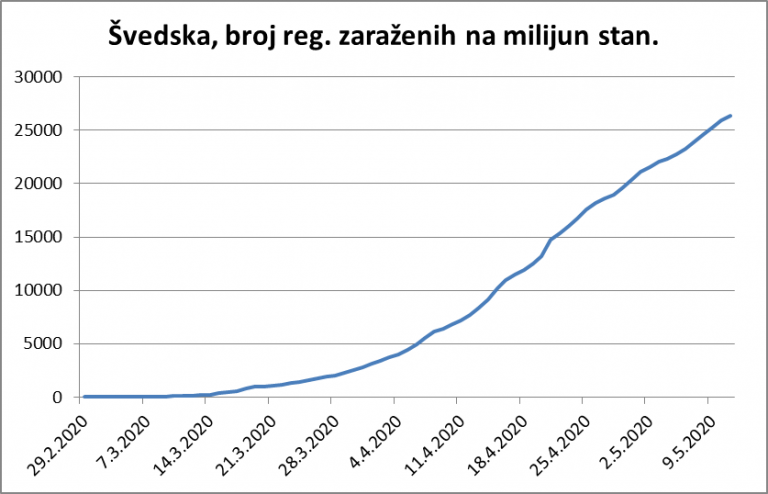
If we take a closer look at Croatia, we will see that linear growth has already been achieved around March 22 (just after the earthquake in Zagreb), and from April 16 is very successful in calming the epidemic. It could also be statistically concluded that the average healing time for registered patients is between three and three-and-a-half weeks.
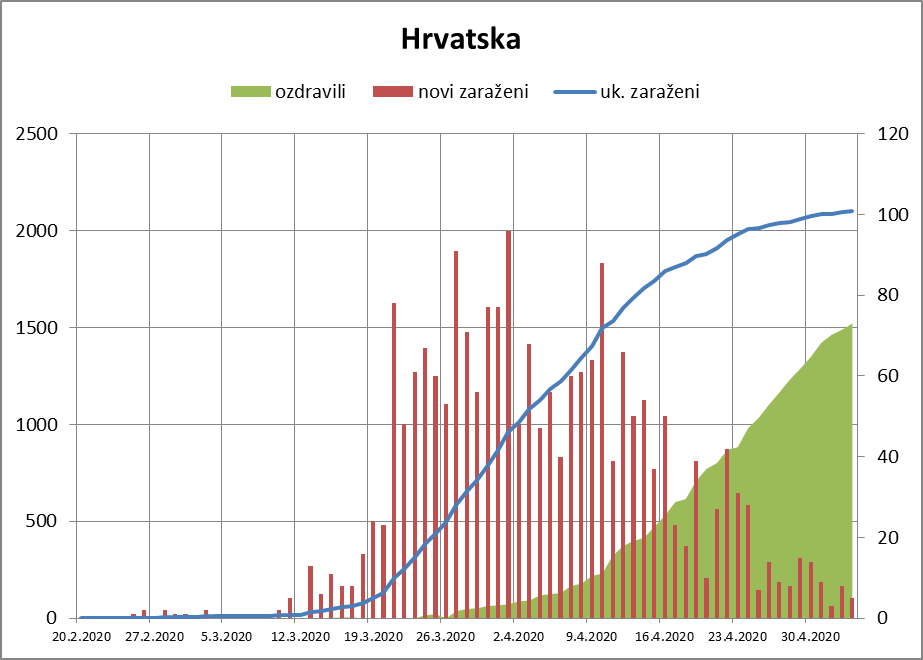
Croatia's excellent result can also be seen in the chart showing the trend in the number of sick and dead.
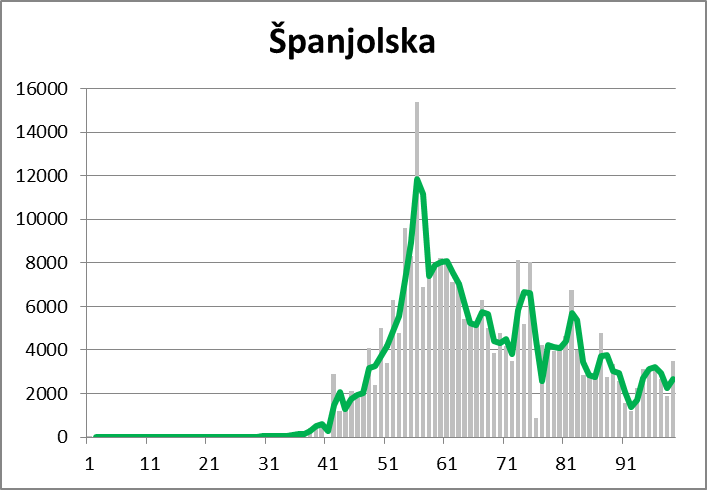
These topics often raise the question of what is a good test measure and whether we are testing enough. An excellent graphical representation of the testing ratio per million population and the percentage of positives shows who optimally tests and who does not. If you are about 10% positive you have found a good measure - Croatia is.
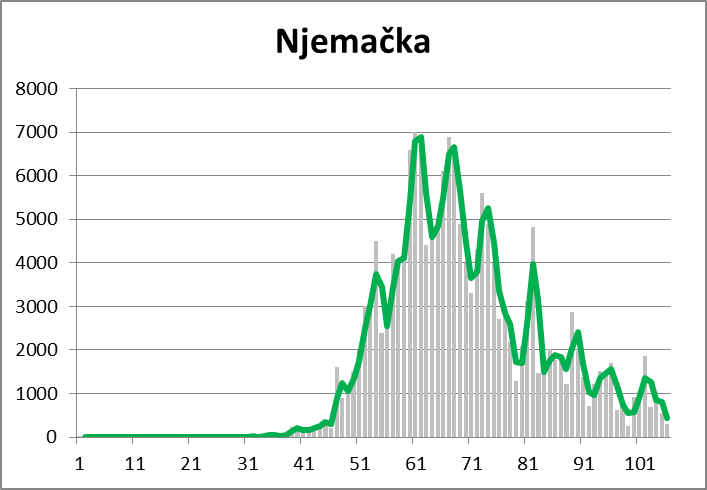
It can be concluded that the epidemiologists were in excellent control of the epidemic and that the Civil Protection Directorate made successful recommendations and measures to mitigate it.
Scientific knowledge, in comparison to the usual political ones, is neither conservative nor radical; they are simply as they are and should be trusted. And so others reasonably rank Croatia among the countries that successfully defeated the coronavirus.
Given that crisis management decisions, especially in the phase of loosening anti-epidemiological measures, are not exclusively health but equally political, further careful monitoring of the situation and comparison with policy decisions and health outcomes in other countries is needed.
Of course, every country can be asked what its long-term perspective is in these new circumstances that will not go away.
Countries that have curbed the epidemic in the sense that they have ensured that their health care system can control the situation, may be far more comfortable developing a further strategy than those who still have to put all their efforts into maintaining the health system's functionality.
And finally - is coronavirus more dangerous than the flu? Yes, but as far as we may know, in just a few months, we are learning something new every day. The important difference is that the behavior of SARS-CoV-2 is still a great unknown and that we do not have vaccines or reliable treatment for severe forms of COVID-19.
Markotić Expects Active Coronavirus Cases Will Fall to Double Digits Soon
May 3, 2020 — The Director of the Zagreb ''Dr. Fran Mihaljevic'' Infectious Diseases Clinic, Alemka Markotic, hopes for the quick unraveling of the coronavirus crisis.
She said in an interview with Nova TV the current rate of new infections and recoveries could give lower Croatia's number of coronavirus patients to double digits within two weeks.
"If we continued at such a good pace, that it would not increase or be without the new ones, that 40-45 people would be cured every day, like today, then in some 10 to 15 days, we might even drop below 100," she said. "I hope so, but we'll see. It is difficult to predict, especially with more severe forms of the disease."
Comparing COVID-19 with the Spanish flu, which has killed many more people, Markotic says the similarities between the two are a sudden occurrence and spread across the globe and that a large number of people are infected.
"It was a rapidly expanding respiratory illness and there was no cure," she said. "What has been a problem, and what we are holding onto today, is that with the flu, it is very common to have pneumonia and a bacterium called streptococcal pneumonia that is responsible for so many deaths. The first antibiotic was discovered only in 1928, 10 years later. We have numerous antibiotics, capabilities and high technology today."
She added the Spanish flu was the result of the dreaded famine that followed World War I. "This virus started today from more developed countries without war."
Asked what problems experts face in treating coronavirus-induced disease, Markotic said that the problem so far was that no medicine intended to treat COVID-19 infection was present. "Now it is finally approved under an expedited procedure, but still for Remdesivir clinical studies, which concluded that it may be more useful but that its implementation should be closely monitored."
When it comes to the possible occurrence of the second wave of the epidemic, Markotic says that it can happen if people do not adhere to epidemiological measures. Markotic said the measures could be reintroduced in that case but would consider introducing measures in those areas where the infection has re-emerged.
Croatia's Phase 2 of Relaxed Measures Starts Tomorrow: Here's What to Expect
May 3, 2020 — Visits to the dentist, doctor, cosmetician, or cobbler are back on, but with strict measures. Chatting with the hairdresser is not advisable.
Due to the favorable epidemiological situation, Croatia on Monday will enter the second phase of relaxing its restrictive measures to control the coronavirus. But it won't be a return to normal, according to Jutarnji List.
The health care system for uninfected patients will be functioning. Outpatient clinics will open. Dentists will be able to see non-emergency cases. Even physicians in private practice will be opened. In addition, clients will again be able to receive services that are in direct contact with people, such as cosmeticians, hairdressers, barbers, pedicures, tattoo parlors.
However, this does not mean that the situation will be the same as before the pandemic. All these activities will be limited by epidemiological measures adopted by the National Civil Protection Headquarters, which apply to dentists as much as they do hairdressers.
Take the example of getting a haircut. Hand sanitizers will be ready when entering the shop. It is recommended that a partition be installed in parts of the parlor, and the space in the waiting area should be at least 1.5 meters removed. Everyone in the salon should be kept at the same distance, except for the hairdresser and the client, since this is simply not feasible. It is generally recommended that social distance be applied wherever possible, including employee rest areas and restrooms.
Although hair salons are often a place to chat, the Civil Protection Directorate recommends that contact be kept to a minimum, and that the usual washcloths for clients should be replaced with disposable ones, and that the salon be ventilated as often as possible, even in bad weather.
No one will be able to accommodate people who have respiratory problems or other symptoms of COVID-19, and it is recommended that all employees have their temperature measured upon arrival.
The time of a customer's entry into a space — salon, office, etc — their contact information (cell phone number) and departure time of the salon will be recorded. This information will be used for contact tracing in the case a customer later tests positive for COVID-19.
Customers should be advised in a timely manner that their service will be provided only if they agree to leave contact information. It is preferable for clients to wear protective masks.
Dentists will have to adhere to even more severe epidemiological measures because of the specific equipment they use that results in aerosols or droplets from the oral cavity. Also, all clients will use disposable gowns, but dentists will have to use protective visors that cover their faces to avoid the possibility of infection.
Each client will be followed by half-hour disinfection of the office.
Analysis: Coronavirus in Croatia Compared to Other European Countries — April 27 Update
April 30, 2020 — A graph showing the number of deaths from or with the SARS-CoV-2 virus per million of the population places Croatia among the five best-ranked countries with the lowest proportional death toll, according to the Johns Hopkins University Coronavirus Database.
In addition to Croatia, there are Greece, Poland, Bulgaria, and - according to the available data - Slovakia. The next low-mortality group includes the Czech Republic, Hungary, Finland, Romania, Estonia, Norway, and Slovenia, with the worst situation affecting Belgium, Spain, Italy, and France. Sweden has around 16 times the death toll per million inhabitants compared to Croatia, a comparison mentioned often due to its lack of measures.
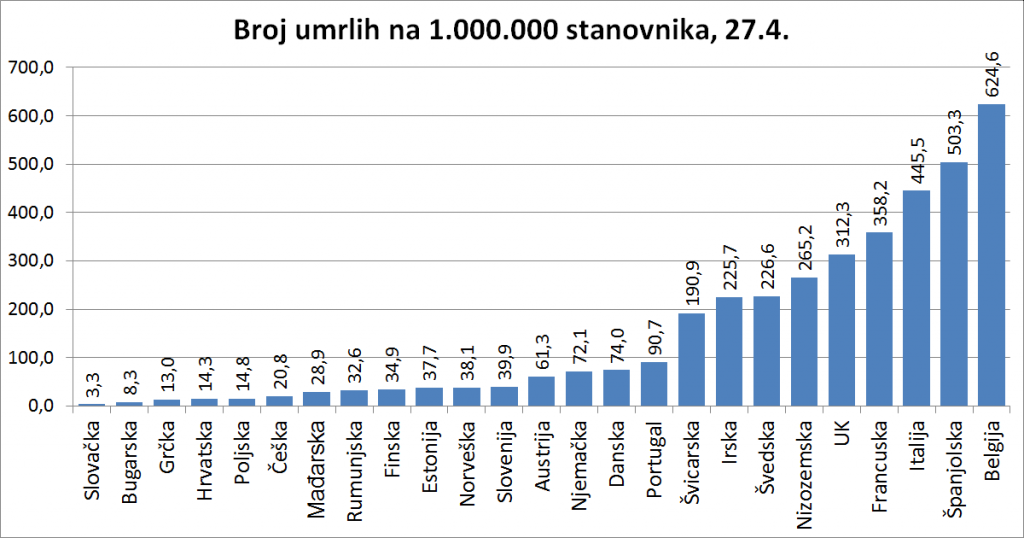
Specifying only the absolute numbers of registered infected persons or persons who died from or with the presence of COVID-19 per country does not give a true picture of the situation, given that there are huge differences in the population of individual states. In this way, for example, the terrible situation in Belgium, with its 11.5 million inhabitants in absolute numbers (7,207), has seemingly far fewer casualties than, for example, Italy with its 60,5 million inhabitants (26,977) for a long time.
It can also be said that Germany, with 6,021 deaths, has far more casualties than 2,274 in Sweden, which is not really the case at all. On the contrary, Germany with 83.5 million inhabitants is significantly more successful in fighting the epidemic so far than Sweden with 10 million inhabitants.
Likewise, it is difficult to compare the development of an epidemic by country in parallel if one looks at the number of registered infected persons on the same date, regardless of the outbreak of the epidemic in each country. The following figure shows the movement of the number of registered patients in several European countries on the same dates.
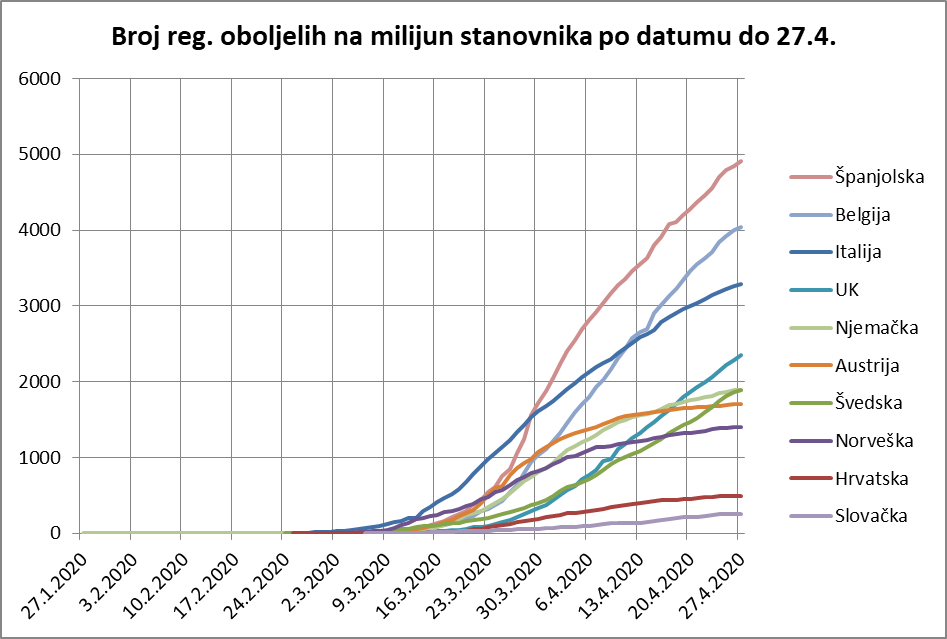
The graph shows a comparison of the currently registered sick per million inhabitants, but it is even more important to note the slopes of each curve in the last week or 14 days. The slope speaks to the rate of spread of the epidemic, of course, as much as there are registered patients.
We do not know the number of unregistered infected persons. It can be seen that Slovakia and Croatia have excellent control over the epidemic; that Norway, Austria, and even Germany have successfully reconciled the earlier spread of the infection, that Italy is slowing down its situation. Spain is having more difficulties, that Belgium and the UK are in a linear curve phase, and it seems that Sweden also achieved a linear curve, although it "overtook" Norway and Austria and "overtook" Germany.
However, here we also provide an overview that begins for each country from the date the first infected person was registered. In this way, it is possible to compare the development and effects of epidemic suppression both in dynamics and in relative numbers per million inhabitants.
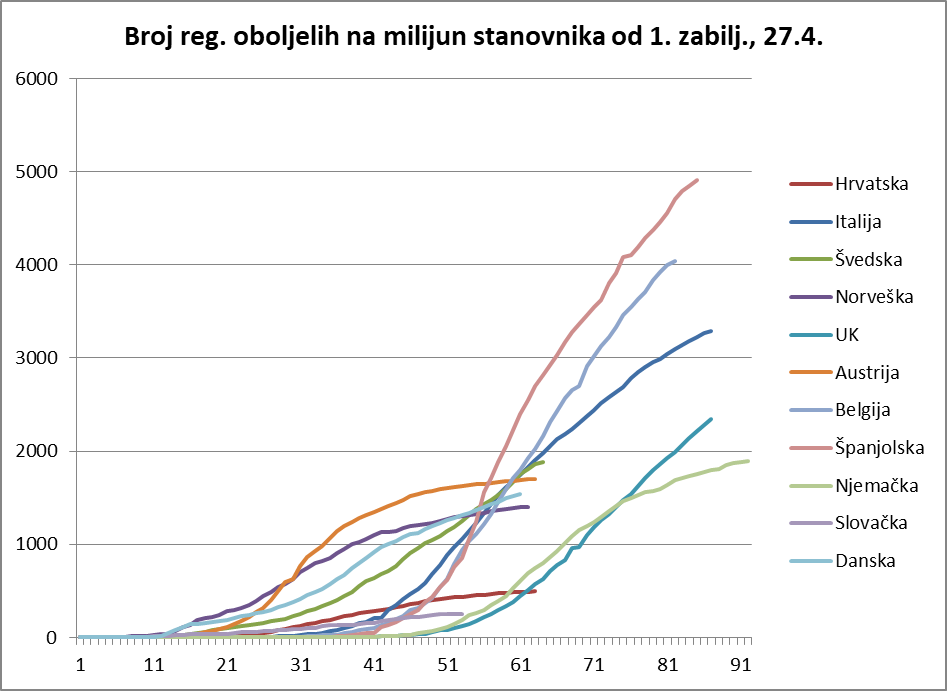
This chart does not show all the countries that are in the first, not only because such a view would become completely opaque, but also because of the abundance of data that needs to be monitored.
At first glance, two groups stand out. The left group is one in which the epidemic developed relatively quickly after the first registered infected person in terms of population: Austria, Norway, Denmark, Sweden, Croatia, and Slovakia. Of course, these are smaller countries. The right group is one in which more time has elapsed since the first registration of the infected person, and these are countries with a larger population.
In the first group, there was a rapid increase in the number of people infected in Austria, but also a very rapid response that reversed the epidemic as early as the 32nd day, and even without "leveling", a consistent reduction in the number of new patients was immediately achieved. The epidemic has calmed down after about 50 days in that country, which of course has a great impact on deciding what to do next.
The epidemic in Norway, with an even sharper start, had a similar course, but apparently by the rapid reaction of the authorities, who reversed the trend around the 32nd day as well and achieved a calming around the 45th day.
In Denmark, the epidemic started very much like in Norway, with the first leveling off happening faster, but with more rapid growth again. Currently, the curve is linear.
The same group is followed by Sweden, which initially did not have rapid growth but, by the 55th day, has grown in the number of registered infected persons Denmark, Norway, and Austria, and there is no sign of the infection slowing.
Viewed in this chart, Croatia and Slovakia are maintaining a linear curve almost from the start of their epidemics. They maintain a very low slope linear curve and have the lowest number of registered infected persons per million inhabitants.
The group of larger countries shows that the worst situation is in Spain, which after exponential growth until the 56th day of the epidemic in its territory and then from around the 62nd day a slightly milder but still large slope with no indication that the epidemic would soon begin to subside.
It is similar in Belgium, which straightened the curve around the 54th day but has since maintained a steady but high (relative) increase in newborns with no indication of calm.
Italy, whose exponential curve started about a week before the one in Spain, reached a more moderate slope of the linear part of the curve around day 49 and shows a slight calming of the epidemic.
Germany, with some time lag compared to the first registered infected person, achieved a curve similar to Austria, with a trend reversal around day 68.
After exponential growth, the UK was able to straighten the curve around day 70, but with no indication of calm.
Looking closer to Sweden, we can see a form of exponential growth in the number of infected.

If we take a closer look at Croatia, we will see that linear growth has already been achieved around March 22 (just after the earthquake in Zagreb), that an even better slope was achieved after April 1, and that from April 16 we can speak of a calming epidemic.

Croatia's excellent result can also be seen in the chart showing the trend in the number of sick and dead.
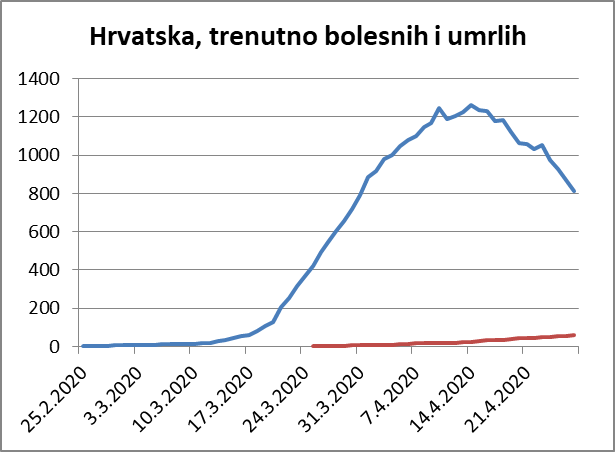
These topics often raise the question of what is a good test measure and whether we are testing enough. An excellent graphical representation of the testing ratio per million population and the percentage of positives shows who optimally tests and who does not. If you are about 10% positive you have found a good measure - Croatia is. Something ugly is coming to Brazil, only if the good weather saves them.

From everything I think it can be concluded how useful it is when policies are established on the basis of scientific knowledge and data. Scientific knowledge, in comparison to the usual political ones, is neither conservative nor radical; they are simply as they are and should be trusted. But these lessons are not exclusively health, but equally political, especially when we talk about loosening up on measures.
Of course, every state can be asked what its long-term prospect is in these new circumstances. That will not go away. Some countries, which have curbed the epidemic in the sense that they have ensured that their health care system can control the situation, maybe far more comfortable developing a further strategy than those who still have to put all their efforts into maintaining the health system's functionality.
And finally - is coronavirus more dangerous than the flu? Yes, but as far as we may know, in just a few months, we learn something new every day. The important difference is that we do not have vaccines and that the virus can mutate more often in a large number of patients.
Find more good visualizations of a pandemic at Croatia Mireo and Velebit.ai.


